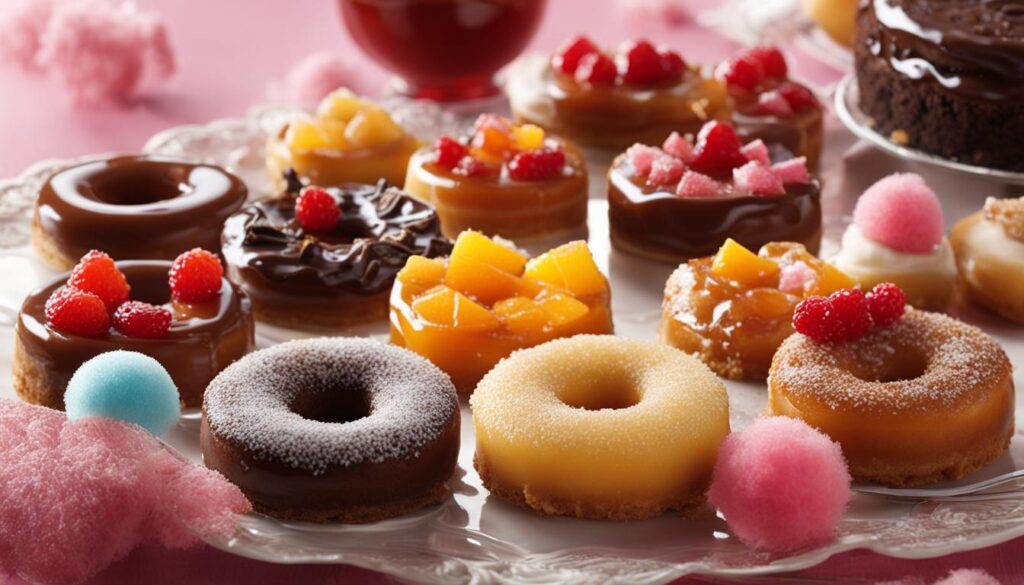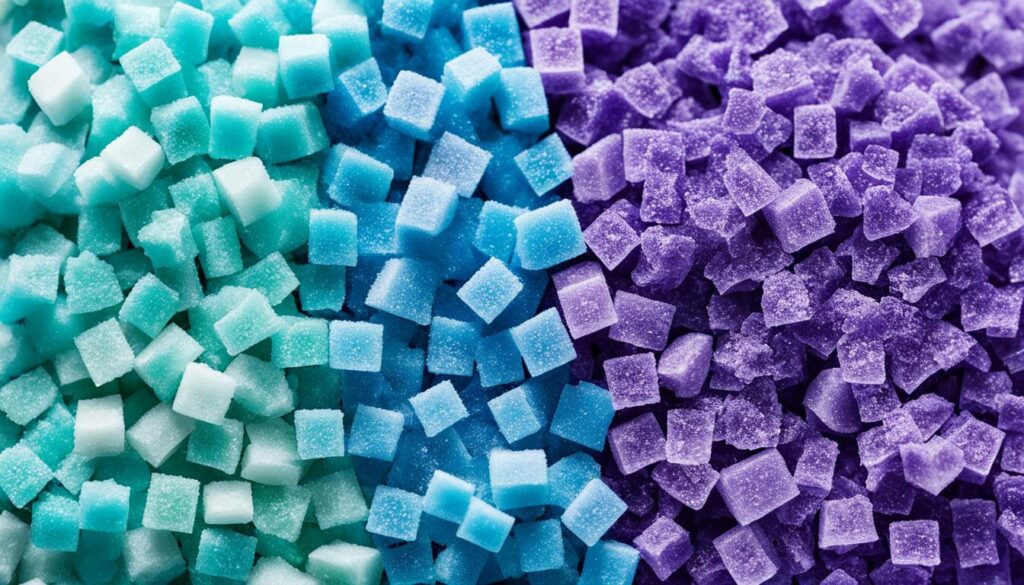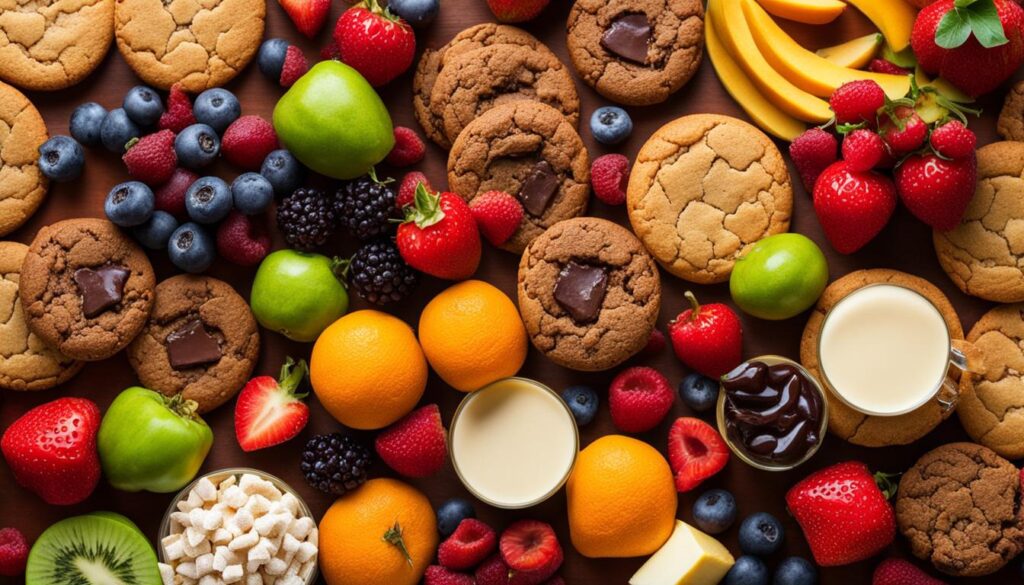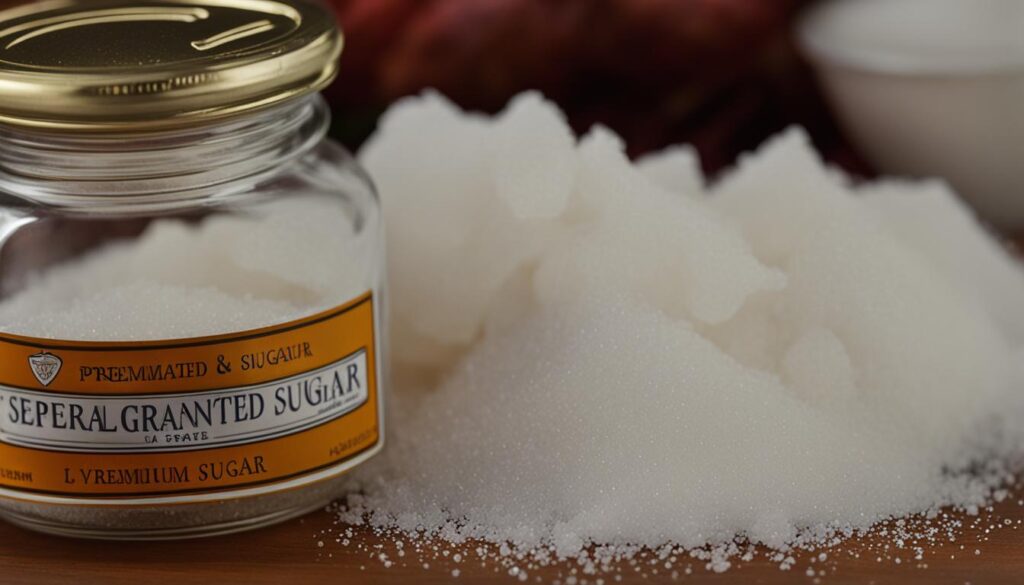Sugar, a form of carbohydrate, is an essential source of energy for the body. There are different types of sugars, including monosaccharides like glucose, galactose, and fructose, as well as disaccharides like sucrose and lactose. While some sugars occur naturally in foods, added sugars are found in processed products. Consuming excessive amounts of added sugar can have adverse health effects, and it is recommended to limit intake. However, sugars from fruits, vegetables, and dairy products are accompanied by other nutrients and can be part of a healthy diet.
Key Takeaways:
- Sugar is a type of carbohydrate that provides energy for the body.
- There are different types of sugars, including monosaccharides and disaccharides.
- Added sugars found in processed foods should be limited in consumption.
- Naturally occurring sugars in fruits, vegetables, and dairy products can be part of a healthy diet.
- Proper sugar intake is important for maintaining a balanced and healthy lifestyle.
Types of Sugar

When it comes to sugar, there are different types that can be classified into two main categories: monosaccharides and disaccharides.
Monosaccharides are sugars composed of a single sugar molecule. They include:
- Glucose: This is the most common sugar and serves as the primary source of energy for the body.
- Galactose: Found in dairy products, galactose is also used by the body for energy.
- Fructose: This naturally occurring sugar is commonly found in fruits and some vegetables.
Disaccharides, on the other hand, are sugars made up of two or more sugar molecules. Some examples of disaccharides are:
- Sucrose: Known as table sugar, sucrose is a combination of glucose and fructose. It is widely used as a sweetener in various food and beverage products.
- Lactose: Lactose is the sugar naturally found in milk and other dairy products.
- Starch: Although not strictly a disaccharide, starch is a complex carbohydrate made up of many glucose molecules linked together. It is a common source of energy in grains, potatoes, and other starchy foods.
The body breaks down carbohydrates, including these sugars, into glucose, which serves as a vital source of energy for various bodily functions.
Image: Types of Sugars
Added Sugars in Food and Drinks

Added sugars play a significant role in the modern diet, as they are found in various processed food and beverage products. These sugars, which are not naturally occurring, are incorporated into the manufacturing process to enhance the taste, texture, and shelf-life of the products. However, it is important to be aware of the potential health risks associated with consuming excessive amounts of added sugars. Therefore, understanding the different forms and names of these added sugars is crucial for making informed dietary choices.
Added sugars can take on many forms, each with their own names and variations. Here are some common examples:
- Raw sugar
- Corn sweetener or syrup
- High fructose corn syrup
- Brown sugar
- Coconut sugar
- Fruit juice concentrates
- Honey
- Molasses
- Maple syrup
- Invert sugar
- Malt sugar
- Dextrose
- Fructose
- Glucose
- Maltose
- Sucrose
- Lactose
- Syrup
These highly processed sugars can be found in various food and drink products, such as carbonated beverages, flavored yogurts, cereal bars, baked goods, and canned fruits. It is essential to read ingredient labels carefully to identify the presence and quantity of added sugars in these products.
By being mindful of the different names and forms of added sugars, individuals can make informed choices about their dietary intake and limit their consumption to maintain a healthy lifestyle.
The Impact of Added Sugars on Health
Excessive consumption of added sugars has been linked to several health issues, including:
- Weight gain and obesity
- Increased risk of type 2 diabetes
- Elevated triglyceride levels
- Increased risk of heart disease
- Poor dental health and tooth decay
It is important to note that natural sugars found in fruits, vegetables, and dairy products are accompanied by essential nutrients and fiber that can benefit overall health. However, added sugars provide empty calories without any nutritional value, contributing to an imbalance in the diet.
“Consuming excessive amounts of added sugars can have detrimental effects on our health, making it essential to be mindful of our sugar intake and choose whole, unprocessed foods whenever possible.” – Dr. Rebecca Jones, Registered Dietitian
Recommended Intake and Health Effects

The Institute of Medicine recommends a daily carbohydrate intake of 130 grams for adults and children over 1 year old, with approximately 45-65% of calories coming from carbohydrates. It is important to note that this recommendation includes all types of carbohydrates, including sugars. However, when it comes to added sugars, the American Heart Association suggests limiting their intake to less than 10% of daily calories.
Excessive sugar consumption can have detrimental effects on health. High blood glucose levels resulting from an overconsumption of sugar can lead to various health conditions. One notable condition is diabetes, a chronic disease characterized by elevated blood sugar levels. Furthermore, excessive sugar intake can contribute to obesity, tooth decay, inflammation, and an increased risk of cardiovascular problems and dementia.
To maintain a balanced and healthy lifestyle, it is crucial to be mindful of the recommended sugar intake and limit the consumption of added sugars. By paying attention to the amount of sugar in food and drinks and making conscious choices, individuals can reduce their risk of developing health issues associated with excessive sugar consumption.
Effects of Excessive Sugar Consumption:
- Increased risk of diabetes
- Obesity
- Tooth decay
- Inflammation
- Cardiovascular problems
- Dementia
Excess sugar consumption can have serious health consequences, so it is essential to be mindful and make informed choices about sugar intake. A balanced diet that includes the recommended amounts of carbohydrates, including sugars, can support overall health and well-being.
Sugar as a Preservative and Flavor Enhancer
Sugar serves a dual role in the culinary world, acting as both a preservative and a flavor enhancer. Let’s explore how sugar performs these functions and elevates the taste of our favorite dishes.
As a preservative, sugar has been utilized for centuries to prevent spoilage and extend the shelf life of various food products. Its unique ability to draw out moisture creates an environment that inhibits the growth of bacteria and molds. This preservation process is commonly employed in items such as jams, jellies, and pickles, ensuring they remain fresh and safe to consume for an extended period.
Sugar’s moisture-absorbing properties make it an effective tool in combating spoilage and preserving the quality of foods.
Furthermore, sugar plays a crucial role in enhancing flavors by harmonizing and intensifying taste sensations. Its sweetening properties can balance out acidity or bitterness in savory dishes, creating a more well-rounded and enjoyable flavor profile. The addition of sugar can impart depth and complexity, elevating the overall taste experience.
Sugar’s Impact on Flavor
Whether it’s sprinkling a pinch of sugar in a tomato sauce to reduce tanginess or adding a spoonful to a vinaigrette to mellow out the sharpness, sugar has the ability to transform and enhance flavors in numerous recipes. By understanding the chemistry of taste, chefs and home cooks can manipulate sugar to achieve the desired balance and harmony in their dishes.
Moreover, sugar can enhance the flavors of other ingredients, highlighting their natural taste and aroma. It amplifies the sweetness of fruits, enhances the richness of chocolate, and brings out the subtle nuances of spices and herbs. In the world of pastry and baking, sugar plays a central role, bringing sweetness and tenderness to cakes, cookies, and pastries, while also contributing to browning and caramelization.
To summarize, sugar’s role as a preservative helps maintain the quality and freshness of various food products, while its flavor-enhancing properties elevate the taste experience. It’s no wonder that sugar has become an indispensable ingredient in countless culinary creations, both sweet and savory.
| Benefits of Sugar as a Preservative and Flavor Enhancer | Examples |
|---|---|
| Extended shelf life of food products | Jams, jellies, pickles |
| Balancing acidity and bitterness | Tomato sauces, vinaigrettes |
| Enhancing natural flavors | Fruits, chocolate, spices, herbs |
| Contributing to tenderness and caramelization | Cakes, cookies, pastries |
Culinary Uses of Sugar

Sugar is an essential ingredient in the culinary world, adding sweetness and enhancing flavors to a wide range of dishes. From beverages to desserts, sugar plays a crucial role in creating delightful culinary experiences.
Sugar in Cooking
When it comes to cooking, sugar can be used to balance flavors, add depth, and create a harmonious taste profile. It can be incorporated into savory dishes to offset acidity or bitterness, creating a well-rounded flavor. For example, a touch of sugar can be added to tomato-based pasta sauces or salad dressings to enhance the overall taste. Additionally, sugar is often used in marinades and glazes for proteins like meat or poultry to achieve a caramelized finish and impart a subtle sweetness.
Sugar in Baking
In baking, sugar is not only a sweetener but also a crucial ingredient responsible for the texture, tenderness, and browning of baked goods. When combined with fats, sugar helps create a tender crumb by limiting gluten development in the dough or batter. It also contributes to the moisture retention, resulting in soft and moist cakes, cookies, and pastries. Furthermore, sugar aids in the caramelization process during baking, giving baked goods a beautiful golden brown color and a rich flavor profile.
Sugar in Desserts
Desserts are often the perfect canvas for showcasing the versatility of sugar. It adds sweetness and enhances the taste of cakes, pies, puddings, and other sweet treats. Whether it’s a decadent chocolate cake, a creamy custard, or a fruity pie, sugar plays a central role in achieving the desired level of sweetness and flavor balance. Without sugar, desserts would be devoid of the delightful indulgence that brings joy to our taste buds.
Whether you’re a professional chef or an enthusiastic home cook, sugar is an indispensable ingredient in the culinary world. Its ability to sweeten, enhance flavors, and contribute to the overall texture and appearance of dishes makes it an essential tool in the kitchen.
So, the next time you’re cooking or baking, don’t forget to harness the power of sugar to elevate your culinary creations. From balancing flavors in savory dishes to adding sweetness and creating delectable desserts, sugar is a versatile ingredient that truly enhances the art of cooking.
Household and Personal Product Uses

While sugar is commonly associated with culinary applications, its usefulness extends beyond the kitchen. In fact, sugar is a versatile ingredient that can be found in a variety of household and personal care products. Let’s explore some of its unique uses:
Sugar in Personal Products
One popular application of sugar in personal care is as a key component in scrubs and exfoliants. The abrasive texture of sugar helps to gently remove dead skin cells, leaving the skin feeling smooth and rejuvenated. Whether it’s a sugar scrub for the face or a full-body exfoliant, these products can be a luxurious addition to any skincare routine.
Sugar in Household Products
Sugar’s abrasive nature also makes it an effective ingredient in homemade cleaning solutions. Whether you’re dealing with tough stains, grime, or unwanted odors, sugar can provide an eco-friendly solution. By mixing sugar with other household ingredients, such as vinegar or lemon juice, you can create natural cleaning agents that are both effective and safe for the environment.
The versatility of sugar doesn’t stop there. It can also be used to freshen the air in your home. By simmering a mixture of water, sugar, and your favorite aromatic ingredients, such as citrus peels or herbs, you can create a natural air freshener that will leave your space smelling delightful.
However, it’s important to remember that while sugar can be beneficial in personal and household products, moderation is key. Excessive use of sugar in skincare or cleaning products may be harsh on sensitive skin or leave behind unwanted residue. Always follow product instructions and consult with a dermatologist or professional cleaner if you have any concerns.
In conclusion, sugar’s versatility goes beyond its culinary uses. It can be a valuable addition to personal care and household products, providing natural exfoliation and cleaning properties. Just remember to use sugar in moderation and follow recommended guidelines for optimal results.
Alternative Uses and Benefits of Sugar

Besides its culinary and household applications, sugar offers a wide range of alternative uses and surprising benefits. From helping with cleaning to creating beautiful crafts, sugar can serve various purposes beyond its traditional role in the kitchen. Let’s explore some of the creative uses and advantages of sugar.
Cleaning and Polishing
Sugar can act as a gentle abrasive, making it useful for cleaning delicate surfaces. Its fine texture allows for effective scrubbing without causing damage. Simply mix sugar with a small amount of water or a cleaning solution to create a paste and apply it to the surface. Gently scrub in small circular motions and rinse to reveal a polished and renewed appearance.
Rust and Tarnish Removal
If you have metal objects or fixtures that have developed rust or tarnish, sugar can come to the rescue. Create a mixture of equal parts sugar and water to form a paste and apply it to the affected areas. Let it sit for a few minutes before scrubbing gently with a soft cloth or brush. Rinse thoroughly and admire the restored shine of your metal belongings.
Decorative Crafts and Edible Decorations
Sugar can be a versatile tool for creating decorative crafts and edible decorations. Use colored sugar or add food coloring to regular sugar to create vibrant toppings for cupcakes, cookies, or cakes. You can also mold sugar into various shapes and forms, such as flowers or letters, to adorn desserts or special occasions. Explore your creativity and let sugar beautify your culinary creations.
Medicinal Applications
In addition to its culinary and decorative uses, sugar has even found its way into medicinal applications. Sugar can aid in wound healing due to its ability to absorb moisture and create a barrier against bacteria. It can also be found as a component in certain medications, such as cough syrups, where it acts as a sweetening agent and helps mask bitter tastes.
As you can see, sugar has a myriad of alternative uses and benefits beyond its role as a sweetener and flavor enhancer. From cleaning and polishing to creating edible decorations and aiding in wound healing, sugar showcases its versatility and usefulness in various aspects of our lives. However, it is important to remember that moderation is key when it comes to consuming sugar in our diets to maintain a balanced and healthy lifestyle.
Selecting and Storing Sugar

When it comes to selecting sugar, it’s important to choose the best quality and the right type for your specific recipe or purpose. There are several popular options available in the market, each with its own unique characteristics and uses. Here are some of the common types of sugar to consider:
- Granulated sugar: The most commonly used form of sugar, with fine crystals that dissolve easily in both hot and cold preparations.
- Brown sugar: Known for its rich flavor and moist texture, brown sugar is often used in baking and adds a caramel-like taste to dishes.
- Powdered sugar: Also known as confectioners’ sugar, this finely ground sugar is commonly used to make frosting, glazes, and dusting desserts.
- Specialty sugars: There are various specialty sugars available, such as demerara and turbinado sugar. These sugars have larger crystals and retain some of the natural molasses, giving them a distinct flavor and texture.
Once you have selected the right sugar, it’s essential to store it properly to maintain its freshness and prevent clumping. Here are some tips for storing sugar:
- Choose a cool, dry place: Sugar should be stored in a cool and dry environment to prevent moisture absorption, which can lead to clumping.
- Use an airtight container: Transfer the sugar into an airtight container to protect it from exposure to air and humidity.
- Avoid direct sunlight: Keep the sugar away from direct sunlight, as exposure to light can degrade its quality and affect its flavor.
By following these guidelines, you can ensure that your sugar stays fresh and ready to use whenever you need it.
| Type of Sugar | Description | Common Uses |
|---|---|---|
| Granulated sugar | Fine crystals that dissolve easily | General baking and sweetening beverages |
| Brown sugar | Moist texture, rich flavor | Baking, caramel sauces, spiced desserts |
| Powdered sugar | Finely ground sugar | Frosting, dusting desserts, sweetening beverages |
| Specialty sugars | Larger crystals, retain natural molasses | Garnishing, specialty baking, adding texture |
Usage Tips and Cautions
When it comes to using sugar in cooking and baking, it’s essential to follow recipe instructions to achieve optimal results. Different recipes may require specific types of sugar or call for adjustments to achieve the desired sweetness. Mixing granulated sugar with wet ingredients or creaming it with butter can help create a light and fluffy texture in baked goods.
However, it’s crucial to be cautious of excessive sugar consumption and practice moderation. The American Heart Association recommends limiting added sugar intake to less than 10% of daily calories. This includes both sugar added during food preparation and hidden sugars in processed foods and beverages.
“Consuming excessive amounts of added sugar can lead to a range of health issues, including obesity, type 2 diabetes, and cardiovascular diseases.”
Here are some tips to help you use sugar wisely:
- Measure sugar accurately: Use measuring cups or a kitchen scale to ensure the right amount of sugar goes into your recipes. This helps maintain the desired sweetness without overdoing it.
- Explore natural sweeteners: Consider using alternatives to refined white sugar, such as honey, maple syrup, or stevia. These options can add sweetness with additional flavor nuances.
- Experiment with sugar substitutes: Artificial sweeteners, like sucralose or erythritol, can be used as sugar replacements in some recipes. However, they may have different properties, so it’s important to follow product-specific instructions.
- Consider reducing sugar: If a recipe calls for a considerable amount of sugar, try gradually reducing it to find a level that still satisfies your taste buds. In some cases, spices like cinnamon or vanilla extract can enhance sweetness without extra sugar.
- Consult a healthcare professional: If you have specific dietary requirements or concerns about sugar consumption, it’s advisable to consult with a registered dietitian or healthcare provider. They can provide personalized recommendations based on your individual needs.
Remember, sugar can be a delightful addition to your culinary creations, but it’s essential to enjoy it in moderation and be mindful of its potential health effects. By incorporating these usage tips and cautions, you can savor the sweetness while maintaining a balanced and healthy lifestyle.
Common Types of Sugar and Their Culinary Uses
| Type of Sugar | Culinary Use |
|---|---|
| Granulated Sugar | Commonly used in baking, beverages, sauces, and general sweetening |
| Brown Sugar | Imparts a rich flavor, often used in baking, glazes, and marinades |
| Powdered Sugar (Confectioners’ Sugar) | Used for icing, frosting, dusting, or as a decorative touch on desserts |
| Raw/Unrefined Sugar (e.g., Demerara, Turbinado) | Provides a subtle caramel flavor and texture, perfect for sprinkling on top of baked goods or in coffee |
| Honey | Sweetens beverages, dressings, sauces, and baked goods. It can also add flavor and moisture to dishes |
| Maple Syrup | A versatile sweetener for pancakes, waffles, oatmeal, desserts, and savory dishes like glazed salmon |
Remember to tailor your sugar choice to the specific requirements of your recipe, taking into account flavor, moisture, and texture considerations. Whether it’s making a batch of cookies or preparing a savory sauce, the right sugar can elevate your culinary creations.
Conclusion
Sugar is a versatile ingredient that plays a crucial role in various aspects of our lives. From adding sweetness to our favorite desserts to preserving jams and jellies, sugar offers a multitude of uses in the kitchen. Furthermore, its ability to enhance flavors and balance taste sensations makes it an indispensable ingredient in both sweet and savory dishes. Beyond culinary applications, sugar can also be found in personal care products, where its exfoliating properties help maintain smooth and healthy skin. Additionally, it has varied applications in household cleaning and crafting.
However, it’s important to consume sugar in moderation and make informed choices about our intake. While sugars naturally present in fruits, vegetables, and dairy products can be part of a balanced diet, added sugars found in processed foods should be limited. Excessive sugar consumption can lead to health issues such as diabetes, obesity, tooth decay, inflammation, and increased risk of cardiovascular problems and dementia.
By understanding the different types of sugars, recommended intake guidelines, and potential health effects, we can enjoy the benefits of sugar while minimizing risks. Whether we’re selecting the right type and quality of sugar for our recipes or being cautious of portion sizes and added sugars, we can maintain a balanced and healthy lifestyle. So let’s savor the sweetness and creativity that sugar brings to our lives, while making conscious and mindful choices about our sugar consumption.
FAQ
What are the different types of sugars?
The different types of sugars include monosaccharides like glucose, galactose, and fructose, as well as disaccharides like sucrose and lactose.
What are added sugars?
Added sugars are sugars that are not naturally occurring in foods and drinks. They can be found in various forms, such as raw sugar, high fructose corn syrup, honey, and fruit juice concentrates.
What are the recommended daily intakes of sugar?
The Institute of Medicine recommends a daily carbohydrate intake of 130 grams for adults and children over 1 year old, with approximately 45-65% of calories coming from carbohydrates. The American Heart Association suggests that less than 10% of daily calories should come from added sugars.
What are the health effects of excessive sugar consumption?
Excessive sugar consumption can lead to high blood glucose levels, which can have serious health consequences, including diabetes, obesity, tooth decay, inflammation, and increased risk of cardiovascular problems and dementia.
How is sugar used as a preservative?
Sugar’s ability to draw out moisture helps prevent spoilage and extend the shelf life of jams, jellies, pickles, and other food products.
What are the culinary uses of sugar?
Sugar can be used to sweeten beverages, add sweetness to desserts like cakes and cookies, create texture and tenderness in baked goods, and balance flavors in sauces and glazes.
What are some household and personal product uses for sugar?
Sugar can be found in personal care products like scrubs and exfoliants, homemade cleaning solutions, and natural air fresheners due to its abrasive nature.
What are some alternative uses and benefits of sugar?
Sugar can be used as a gentle abrasive for delicate surfaces, remove rust or tarnish from metal, create decorative crafts or edible decorations, and be used in medicinal applications like wound healing.
How should sugar be selected and stored?
It is important to consider the quality and type of sugar needed for a specific recipe or purpose. Popular options include granulated sugar, brown sugar, powdered sugar, and specialty sugars like demerara or turbinado. Sugar should be stored in a cool, dry place in an airtight container to ensure freshness and prevent clumping.
What are some usage tips and cautions for sugar?
When using sugar in cooking or baking, it is important to follow recipe instructions for optimal results. Additionally, it is crucial to be mindful of portion sizes and limit overall sugar intake to prevent adverse health effects. Moderation is key, and it is advisable to consult with a healthcare professional for personalized recommendations based on individual dietary needs.
What are the uses and benefits of sugar?
Sugar has various uses in the kitchen, personal care, household, and beyond. It provides sweetness, enhances flavors, acts as a preservative, and offers a multitude of creative possibilities. However, it is important to consume sugar in moderation and be mindful of added sugar intake to maintain a balanced and healthy lifestyle.






